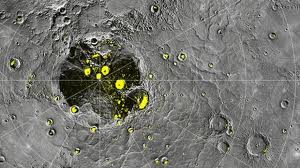A NASA spacecraft has found further tantalizing evidence for the existence of water ice at Mercury's poles. Though surface temperatures can soar above 400 C, some craters at Mercury's poles are permanently in shadow, turning them into so-called cold traps.
Previous work has revealed patches near Mercury's poles that strongly reflect radar - a characteristic of ice. Now, the Messenger probe has shown that these radar-bright patches line up precisely with the shadowed craters. Messenger is only the second spacecraft - after Mariner 10 in the 1970s - to have visited the innermost planet.
Until Messenger arrived, large swathes of Mercury's surface had never been mapped. Maria Zuber, from the Massachusetts Institute of Technology, who is a co-investigator on the Messenger mission, said the most interesting interpretation of the radar observations is that they were due to water ice.
Previous work has revealed patches near Mercury's poles that strongly reflect radar - a characteristic of ice. Now, the Messenger probe has shown that these radar-bright patches line up precisely with the shadowed craters. Messenger is only the second spacecraft - after Mariner 10 in the 1970s - to have visited the innermost planet.
Until Messenger arrived, large swathes of Mercury's surface had never been mapped. Maria Zuber, from the Massachusetts Institute of Technology, who is a co-investigator on the Messenger mission, said the most interesting interpretation of the radar observations is that they were due to water ice.

No comments:
Post a Comment